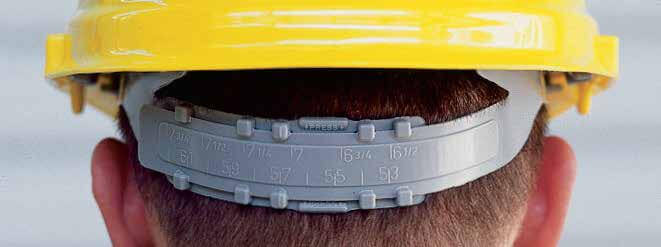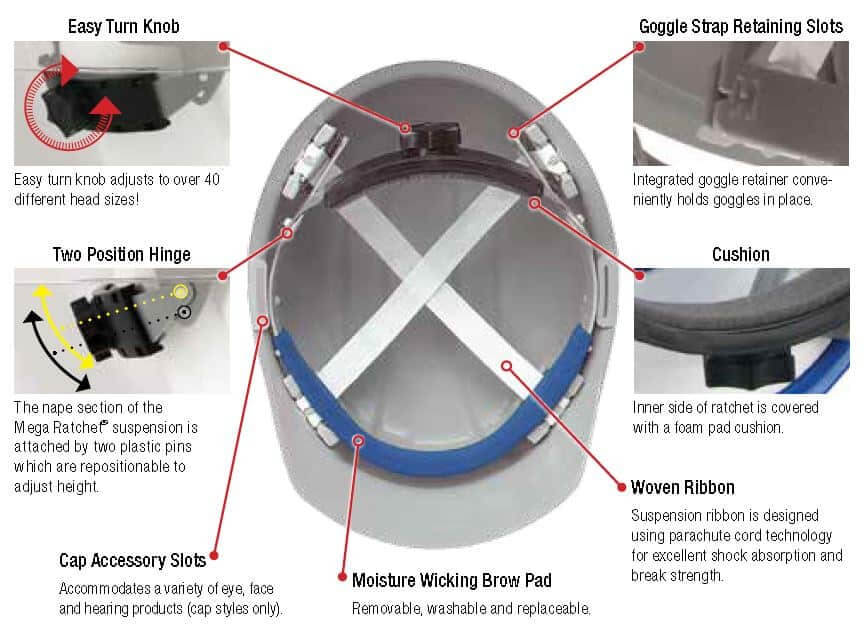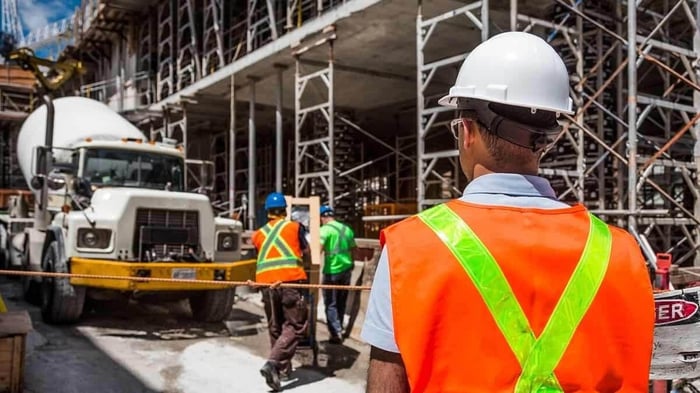Difference Between Slide Lock and Mega Ratchet Safety Helmet Adjustments
The Difference Between Slide Lock and Mega Ratchet Safety Helmet Adjustments is subtle. Slide-Lock adjustment is used in many ERB Safety Helmets. The Slide-Lock adjustment for head sizes 6.5 - 8 (The Slide-Lock suspension easily adjusts to over 40 different head sizes between sizes 6.5 - 8. The suspension material is specially formulated for pliable comfort and strength as well as to provide a smooth sliding action.)


The Mega Ratchet size adjustment for head sizes 6.5 - 8 is used in Many ERB Safety Helmets (The “Secure-Fit” ratchet features an easy turn knob that allows size adjustment from head sizes 6.5 - 8 without removing the helmet. Each turn of the ratchet knob automatically locks with 50 meshing teeth securing the position. The no-slip hold maintains the desired fit even in the most physically active jobs or extreme weather conditions. The hinged ratchet fits low on the nape of the neck and is height-adjustable for a perfect fit. The ratchet mechanism is cushioned with thick sponge padding for long-lasting comfort.
Benefits of Wearing Safety Helmets
Wearing safety helmets is crucial in a variety of different environemnts, from construction sites to recreational activities like cycling and skiing. These protective headgear offer a multitude of benefits.
Safety helmets at Direct Textile Store are designed to protect the head and brain from traumatic injuries. The human skull provides some protection, but it is not sufficient to withstand the impact forces associated with falls, collisions, or flying debris. A safety helmet serves as a crucial barrier between the head and external hazards, dispersing and absorbing the energy of impacts to reduce the risk of severe head injuries such as concussions, skull fractures, and traumatic brain injuries. By cushioning the head and providing a shock-absorbing layer, helmets can significantly mitigate the severity of injuries in the event of accidents, potentially saving lives and preventing long-term disabilities.
These helmets fosters a culture of safety consciousness and risk awareness in various environments. Whether it's a construction site, a manufacturing facility, or a sports arena, the sight of individuals donning helmets sends a powerful message about the importance of prioritizing safety. It reinforces the notion that personal protective equipment is not optional but essential for minimizing workplace hazards and ensuring everyone's well-being. By promoting a culture where safety is valued and prioritized, organizations can reduce the incidence of accidents and create a conducive environment for productivity, morale, and employee retention.
Additionally, safety helmets offer psychological reassurance and confidence to individuals engaging in high-risk activities. Knowing that they are equipped with proper protective gear gives them a sense of security and peace of mind, allowing them to focus on their tasks or enjoy their recreational pursuits without undue anxiety or fear of injury. This psychological benefit is especially pertinent in industries such as construction and motorcycling, where workers face inherent risks on a daily basis. By investing in quality helmets and encouraging their use, employers and organizations demonstrate their commitment to employee welfare and foster a sense of trust and loyalty among their workforce.
Furthermore, the benefits of wearing safety helmets extend beyond individual protection to broader societal impacts. By reducing the incidence and severity of head injuries, helmets contribute to the alleviation of the burden on healthcare systems and society at large. The cost of treating traumatic brain injuries and other head injuries can be staggering, not to mention the long-term emotional and economic toll on affected individuals and their families. By preventing or mitigating such injuries, safety helmets help to reduce healthcare costs, improve productivity, and enhance overall societal well-being.
Adjusting safety helmets correctly is essential for ensuring safety and performance, but the process can be difficult if you are not familiar with the different types of adjustments. Understanding the differences between slide lock and mega ratchet safety helmet adjustments is essential for making an informed choice. Slide lock safety helmet adjustment systems have thin plastic or metal pieces that slide together, which allows users to loosen the helmet fit so it can be pulled off easily. Meanwhile, Mega Ratchet safety helmet adjustment systems have a system of large plastic components with openings into which a ratchet fits, allowing users to quickly adjust the tension of their safety helmets with far less fuss and effort than slide locks. Either type of safety helmet adjustment system helps ensure a snug and secure fit but depending on convenience, comfort, and budget needs users may want to choose one type over another.

About the Author
Haley Bridges, Marketing Assistant at Direct Textile Store
Haley Bridges has served as Marketing Assistant at Direct Textile Store, where she specializes in hospitality linens, uniforms, and bulk textile solutions. She works closely with hotels, restaurants, and healthcare facilities to match them with durable, high-quality products that balance both performance and value. Haley's expertise in textile sourcing and merchandising strategy helps businesses make confident purchasing decisions while staying ahead of industry trends.
If you need assistance, contact Direct Textile Store Customer Service at 800-615-5822




